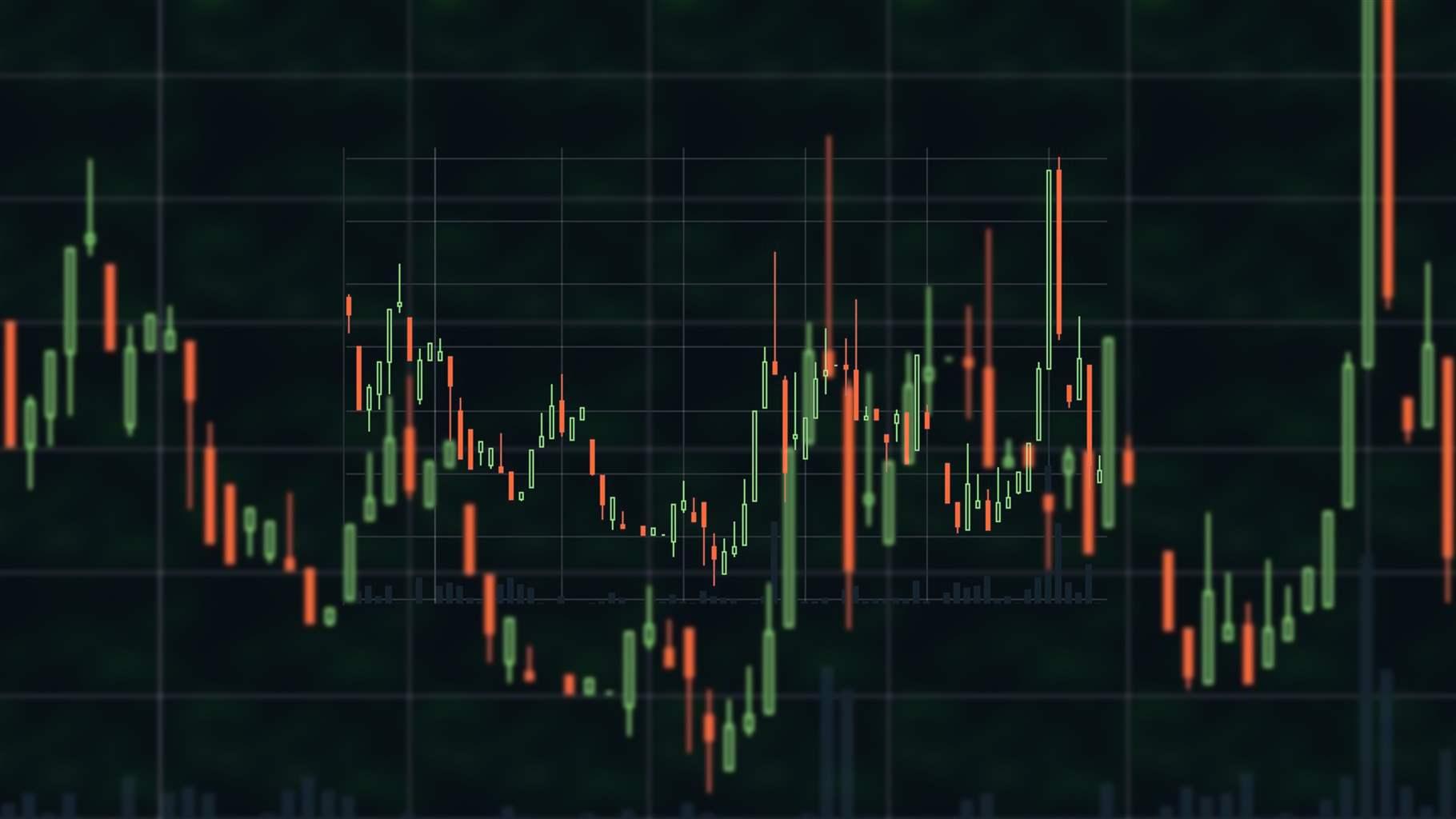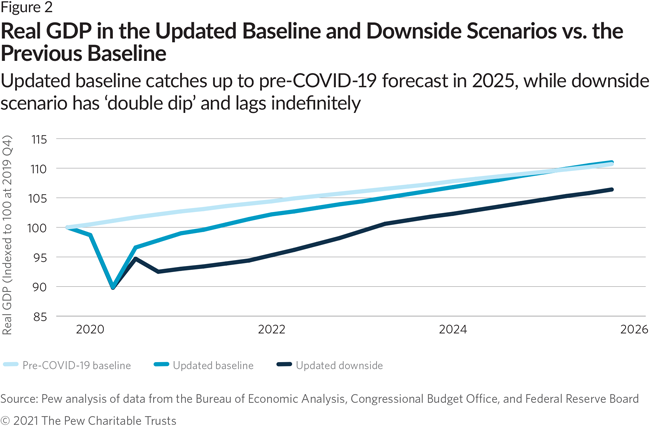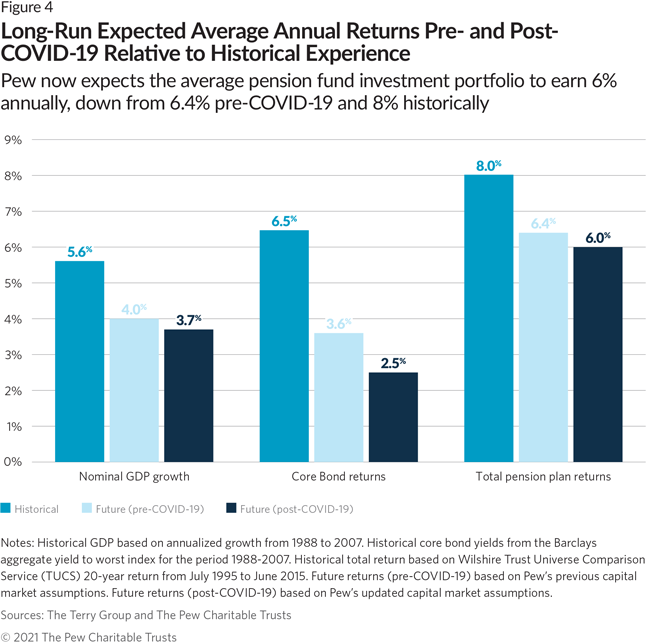Stress Testing of Public Pensions Can Help States Navigate the COVID-19 Economy
Pew’s updated analysis framework accounts for reduced revenue, long-term investment outlooks

Overview
The COVID-19 pandemic has upended life in the U.S. and disrupted the economy. Real gross domestic product (GDP) fell sharply in the second quarter of 2020 while job losses soared and state and local government finances weakened. Public pension systems, funded by those same governments, only narrowly averted large losses in the spring after a historic stock market rally boosted investment earnings.
Economic data released in January and February 2021 by the federal government, including the Congressional
Budget Office (CBO), showed signs of improvement. According to advance estimates from the Bureau of Economic Analysis (BEA),1 the economy held ground in the fourth quarter of 2020 following a sharp rebound in the summer. And with vaccine distribution now underway, the outlook for recovery has improved. By 2025, CBO expects real GDP and labor force participation rates to recover close to their pre-pandemic trajectories— significant upgrades over its July 2020 forecast.2
At the same time, CBO notes an unusually high level of uncertainty around the projected pace of recovery as the pandemic continues nationwide. Even if the recovery goes as expected, effects of the pandemic will likely weigh on the national economy for much of the decade. Lost economic output through 2025 could total in the trillions of dollars, and employment could take years to fully recover. Meanwhile, to aid the economic recovery, the Federal Reserve has committed to keep interest rates at historical lows for the foreseeable future.
For public pension systems, these projections point to potential budget challenges for state and local governments and lower earnings on public pension fund investments. An estimated 6% to 11% decline in state revenues has, in some cases, limited states’ ability to make annual required contributions to pension plans. And over the long run, continued low interest rates, which drive earnings on bonds and other investments, could reduce annual pension fund investment returns. These earnings pay for about two-thirds of pension benefits on average, and a one-quarter to one-half of a percentage point reduction in returns would equate to about $10 billion to $20 billion in lost gains annually.3
Given the risks to government revenues and pension fund investments, policymakers should consider the potential impact of the pandemic on pension balance sheets. One way to determine those impacts is through an analysis called stress testing, which 12 states have already adopted. Stress testing involves the simulation of a range of scenarios for the economy and investment returns to give policymakers a better sense of potential liabilities and costs. That information, then, can help guide retirement system investments and state budgets.
Pew offers a framework for pension system stress testing called “The Foundation for Public Pensions Risk Reporting” that shows how states can use stress testing to navigate economic and investment risks created by the pandemic.4 A recent update to this framework highlights how policymakers can use the most recent economic data to manage the short- and long-term budget challenges to their public retirement systems. These updates include:
- The baseline and downside scenarios have been reset to reflect the current economic environment and the unique risks to an economy already in a downturn. Although the latest BEA data shows that a recovery is underway, the risk of a slowdown—or worse, a double-dip recession—remains. And even in a baseline scenario, with the economy recovering as expected, real GDP does not approach its pre-pandemic trajectory until 2025.
- Investment return assumptions have been revised downward in light of the reduced forecast for GDP and the current low interest rate environment. Over the next 20 years, the typical pension fund investment portfolio may now expect to return about 6% annually, as compared with current target return rates that average 7% or higher.
- The methodology to project long-term state revenues has also been updated to reflect the latest instate forecasts indicating a reduction in resources available to make annual pension contributions. With revenues depressed, meeting scheduled pension payments will require a greater share of state resources, particularly over the next few years.
The economic impact of COVID-19
The economic effects of COVID-19 have been fast and severe. For public pension plans, the pandemic has led to unprecedented volatility in financial markets and short-term revenue pressures on their government sponsors.
In February and March 2020, the stock market declined by more than 30% in a span of five weeks—the largest loss since the financial market crisis of 2007-09 (see Figure 1). Since then, stocks have waged a historic recovery, pushing pension fund returns into positive territory, with the average fund earning 3% for the fiscal year ending June 30, 2020. Pension funds also posted estimated gains of 12% to 16% for the last six months of 2020 as the stock market continued to surge.5
Recent strong market performance can be attributed in part to temporary interventions by the federal government to stabilize the economy, as well as investor expectations of further economic stimulus from Congress. The longer-term outlook for returns on stocks and bonds, however, is less rosy.6
For most state and local governments, the decrease in economic activity during the last quarter of the fiscal year ending June 30 also led to a sharp drop in revenue. Although monthly tax receipts have since improved, state government revenues are still forecast to be down 6% to 11% from pre-pandemic forecasts, on average, during FY 2021 (Figure 1).7 Meanwhile, pandemic-related spending pressures on core services such as public health have increased in many states.
Over the next few years, making scheduled pension payments, which from 2014 to 2018 increased twice as fast as revenue,8 presents the most critical challenge for state policymakers struggling to balance lower levels of revenue and additional spending needs.
The recent challenges of market volatility and declining revenue tie directly to the two forward-looking factors at the center of pension stress testing: investment risk and contribution risk. Pew developed the scenarios presented below to better assess those risks, accounting for the rapid, significant changes to the economic outlook as well as the particular risks to an economy recovering from recession.
New baseline expectations and downside risks
The outlook for the economy as a whole, measured by GDP, provides the foundation for scenario modeling and the starting point for projected pension investment returns and government revenue. Pew’s revised baseline and downside scenarios incorporate two new paths for real GDP in light of the pandemic.
In the baseline, real GDP now follows the CBO’s February 2021 economic forecast, which is generally seen as the gold standard in the industry.9 In the downside scenario, real GDP has been constructed to simulate the impact of a “double-dip” recession, based on a hypothetical scenario included in the Federal Reserve’s second round of 2020 bank stress tests published in September.
Figure 2 shows the path for real GDP in the revised baseline and downside scenarios, relative to its expected trajectory before the pandemic hit. The BEA estimates that real GDP fell 9% in the second quarter of 2020 before bouncing back with 7% growth in the third quarter and 1% growth in the fourth quarter. Although the recovery thus far has been quick, CBO expects economic output to remain below pre-pandemic forecast levels for several years. That, however, represents a significant improvement over its July forecast, which showed real GDP trailing pre-pandemic projections indefinitely.
It is important to note that CBO’s baseline forecast does not attempt to estimate the size, character, and impact of potential policy changes, including further economic stimulus measures. It does, however, account for all legislation enacted up to Jan. 12, 2021—including an additional $900 billion in stimulus passed in December 2020. Additional fiscal stimulus and/or substantial policy changes, if approved, could cause the baseline outlook to further improve.10 Overall, CBO cautions that there are still many uncertainties, with both positive and negative potential implications for the economic outlook.
Analysts view the baseline scenario from CBO as a reasonable median expectation for the U.S. economy. As an alternative, the downside scenario is intended to capture one of the most prominent risks to the ongoing economic recovery: a “double-dip” recession.
To reflect this possibility, the downside scenario is based on the “Alternative Severe” scenario included in the Fed’s second round of bank stress tests published in September 2020.11 The Fed designed this scenario specifically to reflect risks related to the path of the pandemic, including the impact of additional waves of COVID-19 infections and a potential delay in achieving or distributing an effective vaccine. Economists and analysts have viewed a double-dip recession as a distinct possibility since the early stages of the pandemic.12 Although the successful development of vaccines offers hope, the pandemic still has the potential to weigh on economic activity and output, and a double-dip recession remains possible.
The downside scenario assumes the economy suffers an additional setback by the first half of 2021, with output contracting by more than 2% (9% annualized). The recovery resumes the following quarter but is slower than under baseline projections. Even after several years of above-average growth, real GDP in the downside scenario falls persistently short of pre-pandemic projections, as reflected by the output gap in Figure 2.
These economic scenarios also include assumptions about the outlook for financial markets and interest rates, which help to inform the revised outlook for returns on stocks, bonds, and other investments commonly held by public pension funds. Notably, interest rate conditions and expectations have changed dramatically since the pandemic started: The Fed slashed rates to zero in March to combat the fast-moving crisis and has since issued guidance—including the introduction of a new monetary policy framework—suggesting rates will remain near zero for several years with only a gradual liftoff after that.
As Figure 3 shows, both the current environment and future expectations for interest rates are starkly different from the outlook just two years ago. CBO expects it will take roughly a decade for 10-year Treasury rates to climb back to pre-pandemic levels; even then, they are expected to settle in at long-term equilibrium rates that are materially lower than projections from 2018, when Pew initially published its stress testing framework.
As the pandemic and vaccine distribution take their course, downside risks to the U.S. economy will continue to evolve—so Pew will continue to monitor economic conditions and update the baseline and downside scenarios as needed as a new post-pandemic economy and federal policy responses emerge.
The revised long-term investment outlook
The revised forecasts for real GDP and key interest rates have the effect of lowering long-term return assumptions for key asset classes, including stocks and core bonds, which account for 75% of the typical public pension fund portfolio. Long-term equity returns, which are closely correlated with economic growth and projected based on the current market value of stocks, are now estimated to be 6.4%, compared with 6.7% previously. And with interest rates expected to be lower than pre-pandemic levels, bonds are now projected to yield just 2% over the next decade before rising to a long-term yield of 4%, as in Pew’s earlier assumptions.
Overall, the typical pension fund is now expected to return approximately 6% annually over the next 20 years, compared with 6.4% pre-pandemic (Figure 4). This change in outlook is consistent with the reduction in the median long-term return found by a recent survey of pension investment consultants13 and aligns with revisions for public pension return expectations published by S&P Global.14
The dampened outlook for real GDP combined with high stock valuations and expectations of historically low interest rates are the primary drivers of these changes to expected returns for core asset classes and thus for overall pension fund portfolios. For stocks, the lower returns were determined through the use of economic models developed by The Terry Group, including dividend discount models, that tie equity returns to key macroeconomic variables such as GDP and interest rates. Estimates for lower equity returns stem in part from the fact that equity valuations are currently high (for example, based on price-to-earnings ratios). Further, longterm economic output, in nominal terms, is now expected by CBO to be lower than it was before the pandemic, potentially affecting corporate profits and future dividend payments.
Lower bond returns over the next decade reflect the market-based expectation that the Fed will target lower interest rates for an extended period of time. Although declining interest rates have a positive impact on the value of existing bonds, most of these gains have already been realized. In the fiscal year ending June 30, 2020, core bond returns were approximately 9%, buoyed by a rapid decline in interest rates.15 (High bond returns were a major contributor to pension fund returns turning positive for the year.) In the long term, Pew projects bond yields will rise to 4%.
Overall, these interest rate forecasts depend on a range of factors, including the pace of economic recovery and how the Fed chooses to unwind recession-era interest rate policy. For example, if the recovery is faster than expected, with core inflation ticking up, the Fed could decide to raise interest rates more quickly, causing the investment return outlook to change as well.
The revised revenue outlook
The pandemic’s impact on government revenue is already placing pressure on states and cities to keep up with planned annual pension contributions. To date, at least six states have reduced scheduled contributions in their current budgets,16 and the strain on revenue is expected to continue even after the recession lifts.
Recent reports on state revenue collections, however, paint an improved picture over forecasts from spring and summer 2020,17 and a more rapid recovery would limit most of the budget pressure to fiscal years 2021 and 2022. At the same time, aggregate budget deficits could still be in excess of $200 billion, including expenditure increases, over the next two fiscal years.18
To evaluate the impact of pension payments on government budgets, Pew’s framework calculates projected contributions as a share of estimated own-source revenue (OSR). OSR is a measure of taxes and fees controlled by state and local governments, collected and reported by the U.S. Census Bureau, that serves as a proxy for available budget resources. (Holding annual contributions fixed as a share of OSR, and not allowing them to rise with actuarial requirements, is also how Pew assesses contribution risk.) Based on recent in-state forecasts, Pew projects state OSR in aggregate could be around $100 billion lower than pre-pandemic estimates through
FY 2021. The impact on revenue may also be felt for some time. Given the close historical relationship between OSR and GDP, OSR for most states could trail earlier expectations through 2025 (in the same way CBO believes economic output will).
Under current plan policies, pension payments are still likely to increase by 5% or more in FY 2021, in line with historical averages. That increase, combined with lower revenues overall, could allow pension contributions to rise to 11% of OSR in FY 2021, up from an estimated 9% in FY 2019 and 2.5 times the rate from two decades earlier of 4.4%.19
The increase could be even higher if plans choose to lower their discount rates in reflection of the revised outlook for investments. The discount rate is integral to how plans price future pension liabilities. For example, current accounting rules specify that the discount rate be equal to the assumed rate of return on investments. All else being equal, a lower discount rate—and thus, assumed rate of return on investments—will cause the total pension liability to rise. Pew estimates that a 1% reduction in the assumed rate of return could translate to a 20% increase in annual contributions for a typical pension plan, absent a change in funding policy.20 Research indicates, however, that discount rate assumptions tend to be revised downward in smaller increments over time.21
Conclusion
The COVID-19 recession has significantly affected public pension systems and state and local government budgets. State revenues could be down 6% to 11% through FY 2021 and, for some states, could persistently trail expectations made before the pandemic. And although public pension systems escaped large investment losses in FY 2020, over the long run pension funds are projected to have more difficulty meeting investment return targets in a market environment altered by the pandemic-created economic shock.
Pew designed these updates to its stress testing framework to account for the effects of the COVID-19 recession; the updates are intended to help policymakers assess the resiliency of their public retirement systems during a once-in-a-lifetime pandemic. Even with mass vaccinations underway, near- and long-term risks persist. Pew’s stress testing framework is intended to help policymakers manage those risks, allowing governments to better evaluate pension funding strategies and budget priorities in an uncertain economic environment.
Endnotes
- Bureau of Economic Analysis, “Gross Domestic Product, 4th Quarter and Year 2020 (Advance Estimate),” news release, Jan. 28, 2021, https://www.bea.gov/news/2021/gross-domestic-product-4th-quarter-and-year-2020-advance-estimate.
- Congressional Budget Office, “An Overview of the Economic Outlook: 2021 to 2031” (2021), https://www.cbo.gov/system/files/202102/56965-Economic-Outlook.pdf.
- According to the U.S. Census Bureau’s Annual Survey of Public Pension Plans, 2019 release, state and local public pension plans held $4.4 trillion in long-term investments and cash at the end of FY 2019. A 0.25 to 0.5 percentage point drop in their return on investments would thus amount to lost gains of roughly $10 billion to $20 billion in the current year.
- The Pew Charitable Trusts, “Foundation for Public Pensions Risk Reporting” (2018), https://www.hks.harvard.edu/sites/default/files/centers/mrcbg/programs/Foundation%20for%20Pensions%20Risk%20Reporting%20(Strawman).pdf.
- Rebecca A. Sielman, “Public Pension Funding Index, 4th Quarter 2020” (Milliman, 2021), https://us.milliman.com/en/insight/publicpension-funding-index-4th-quarter-2020; Wilshire Trust Universe Comparison Service, “Master Returns: Fed/State DB Master Returns, Dec. 31, 2020,” (2021). Milliman estimates that public pension plans in aggregate earned 4.1% returns in the third quarter of 2020 and 8.4% returns in the fourth quarter—equating to compound returns of more than 12% for the entire six-month period. Preliminary data from Wilshire TUCS show that the median state/federal defined benefit plan earned returns of 15.4% over the same six months.
- Horizon Actuarial Services LLC, “Survey of Capital Market Assumptions, 2020 Edition” (2020), http://www.horizonactuarial.com/uploads/3/0/4/9/30499196/rpt_cma_survey_2020_v0716.pdf.
- L. Dadayan, “State Revenues Continued to Show Growth in December 2020 but Still Depressed from Pandemic” (Urban Institute, 2021); M. Leachman, “States, Localities, Tribal Nations, Territories Need More Federal Aid” (Center on Budget and Policy Priorities, 2021), https://www.cbpp.org/research/state-budget-and-tax/states-localities-tribal-nations-territories-need-more-federal-aid; National Association of State Budget Officers, “The Fiscal Survey of States Fall 2020” (2020), https://higherlogicdownload.s3.amazonaws.com/NASBO/9d2d2db1-c943-4f1b-b750-0fca152d64c2/UploadedImages/Fiscal%20Survey/NASBO_Fall_2020_Fiscal_Survey_of_States_S.pdf. FY 2021 state revenue forecasts continue to be a moving target. In December, the National Association of State Budget Officers reported that current in-state forecasts showed a 10.8% decline in revenue, on average, relative to forecasts made before the pandemic. Since then, the Center on Budget and Policy Priorities believes the situation has improved. In a Jan. 22, 2021, report, it estimated that aggregate FY 2021 revenue declines then stood at 7.8%. Other measures of revenue show a similar impact relative to pre-pandemic estimates. Preliminary data from an Urban Institute report in February 2021 show that state tax revenues, over the 10-month period from March to December 2020, declined 1.8% relative to the same 10 months in 2019. Assuming 4% growth expectations pre-COVID-19, that would amount to a roughly 6% decline relative to pre-COVID-19 forecasts. It is worth emphasizing that these are estimates of the aggregate revenue situation facing states. Each state’s experience has been different, however. Those with economies that are more exposed to the pandemic—e.g., those with outsize reliance on tourism revenues—are likely to have greater challenges, while others with less affected revenue streams may wind up closer to initial expectations.
- Over the five-year period 2014-18, aggregate state and local government own-source revenue grew an average of 4% annually, while government contributions to state and local public pension plans grew an average of 9% annually, according to data from the U.S. Census Bureau.
- Congressional Budget Office, “An Overview of the Economic Outlook: 2021 to 2031.”
- Moody’s Analytics, “U.S. Macroeconomic Outlook: Baseline and Alternative Scenarios,” (January 2021). For example, Moody’s Analytics baseline projections attempt to capture the impact of some expected policy changes. In particular, its January 2021 forecast assumes that Congress passes an additional $1.9 trillion in economic stimulus in calendar year 2021. This assumption has the effect of pushing GDP slightly higher than earlier Moody’s Analytics projections without that impact.
- Board of Governors of the Federal Reserve System, “Supervisory Scenarios for the Resubmission of Capital Plans in the Fourth Quarter of 2020” (2020), https://www.federalreserve.gov/newsevents/pressreleases/files/bcreg20200917a1.pdf.
- L. Sheiner and K. Yilla, “The ABCs of the Post-COVID Economic Recovery,” The Hutchins Center Explains (blog), Brookings, May 4, 2020, https://www.brookings.edu/blog/up-front/2020/05/04/the-abcs-of-the-post-covid-economic-recovery/.
- Horizon Actuarial Services LLC, “Survey of Capital Market Assumptions, 2020 Edition.” The average expected return for a typical pension plan portfolio went down 27 basis points over a 10-year period and 35 basis points over a 20-year period compared with the survey’s 2019 findings.
- S&P Global Ratings, “Assessing U.S. Public Finance Pension and Other Postemployment Obligations for Go Debt, Local Government Go Ratings, and State Ratings” (2019), https://www.spglobal.com/ratings/en/research/articles/191007-guidance-criteria-governments-u-s-public-finance-assessing-u-s-public-finance-pension-and-other-postemploymen-11182009.
- Bloomberg, Bloomberg Barclays U.S. Aggregate Bond Index, accessed Jan. 28, 2021, https://www.bloomberg.com/quote/LBUSTRUU:IND. The Bloomberg Barclays U.S. Aggregate Bond Index went up 8.8% in the fiscal year ending June 30, 2020.
- D. Draine and S. Connolly, “How Pandemic-Driven Revenue Shortfalls Could Affect State Pension Contributions,” The Pew Charitable Trusts, Jan. 13, 2021, https://www.pewtrusts.org/en/research-and-analysis/articles/2021/01/13/how-pandemic-driven-revenue-shortfalls-could-affect-state-pension-contributions.
- M. Leachman and E. McNichol, “Pandemic’s Impact on State Revenues Less Than Earlier Expected but Still Severe” (Center on Budget and Policy Priorities, 2020), https://www.cbpp.org/research/state-budget-and-tax/pandemics-impact-on-state-revenues-less-than-earlierexpected-but.
- D. White, “U.S. State and Local Government Shortfall Update” (Moody’s Analytics, 2020), https://www.ncsl.org/Portals/1/Documents/fiscal/Moody%27s_09.21.20_Shortfall-Update.pdf.
- Historical employer contributions to OSR ratios were calculated with data from the U.S. Census Bureau’s Annual Survey of Public Pension Plans (employer contributions) and Annual Survey of State Government Finances (OSR). FY 2021 ratio was estimated on the assumption that OSR declined -1.6% and -4.4% year over year, respectively, in FY 2020 and FY 2021, consistent with National Association of State Budget Officers data. Meanwhile, employer contributions were assumed to grow at their average growth rate over the period 2014-18 in each of FY 2020 and FY 2021.
- Take, for example, a public pension plan with a funded ratio of 70%, for which a 1% decrease in the discount rate increases the total plan liability by 10%, and in turn, the unfunded liability by 33%. Assuming the plan follows an actuarial funding policy, where amortization of the unfunded liability makes up at least 60% of the employer’s annual contributions, that would mean an increase of 20% or more in the actuarially determined employer contribution.
- National Association of State Retirement Administrators, “NASRA Issue Brief: Public Pension Plan Investment Return Assumptions,” (2020), https://www.nasra.org/files/Issue%20Briefs/NASRAInvReturnAssumptBrief.pdf. The median discount rate for state pension plans fell by 75 basis points over the period 2010-20. On a plan-by-plan basis, approaches for reducing the discount rate vary. Although there are examples of state plans lowering their discount rates by 1% or more in a given year, many also choose policies that stagger the planned reduction over a several-year period.


America’s Overdose Crisis
Sign up for our five-email course explaining the overdose crisis in America, the state of treatment access, and ways to improve care
Sign up

Pension Risk Reporting Updated for Pandemic's Impacts


Public Pension Investments Largely Recover After Slide
















